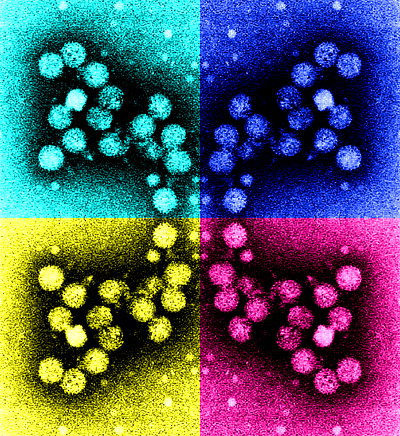Liver talk puts the hard word on Hep C
 The last week saw the annual gathering of the latest findings in liver studies, this year detailing many exciting developments for hepatitis C virus treatment.
The last week saw the annual gathering of the latest findings in liver studies, this year detailing many exciting developments for hepatitis C virus treatment.
Crowds at the International Liver Congress 2014 in London over the weekend have heard details of a range of new approaches to treating the dangerous virus.
Three separate projects have yielded encouragingly high success rates from tests so far.
The first was a multi-pronged attack by pharmaceutical company AbbVie, which uses a three-phase technique to fight hepatitis C virus (HCV) genotype 1 (GT1).
AbbVie’s 3D regimen consists of the HCV NS3/4A protease inhibitor ABT-450 dosed with ritonavir, the NS5A inhibitor ABT-267, and the NS5B RNA polymerase inhibitor ABT-333.
“Using this investigational 3D regimen, with or without ribavirin, these studies have demonstrated consistently high cure rates across a number of patient types, including the more difficult-to-treat subtype GT1a, and HCV patients with compensated cirrhosis,” said Dr. Alessio Aghemo, Gastroenterology and Hepatology Unit, Ospedale Maggiore Policlinico, University of Milan.
The AbbVie study was broken into three rounds of testing. In the first round; patients with chronic HCV GT1 infection and no evidence of liver cirrhosis, were given 12 weeks of treatment with the 3D regimen plus ribavirin (RBV). After 12 weeks, the overall intention-to-treat SVR12 rate was 96.2%. The second round saw HCV GT1a and GT1b patients with cirrhosis tested; 91.8% of patients achieved SVR12 and in the 24 weeks treatment arm, 95.9% of patients achieved SVR12. Finally, a third study treated naïve adults with chronic genotype 1b (GT1b), and no evidence of liver cirrhosis, randomised to receive the 3D regimen with or without (RBV). Following 12 weeks of treatment, 99.0% receiving the regimen without RBV and 99.5% receiving the regimen with RBV achieved SVR12.
Similarly high results were achieved in a second study, which showed that simeprevir 150 mg once-daily for 12 weeks in combination with peginterferon and ribavirin (followed by 12 or 36 weeks of peginterferon and ribavirin) was effective and well tolerated in hepatitis C virus (HCV) genotype 4-infected patients. This was consistent with previous observations in HCV genotype 1-infected patients.
“HCV genotype 4 is a strain of virus which currently only has limited treatment options,” said European Association for the Study of the Liver (EASL) Secretary General Professor Markus Peck-Radosavljevic.
“We therefore welcome these positive results for the simeprevir-based regimen.”
Although HCV genotype 4 is mainly found in the Middle East, Egypt and Central Africa, it has recently spread in several Western countries, particularly in Europe, with rates of 10% to 24%.
Patients of Egyptian ancestry infected with Genotype 4 HCV achieved particularly high virological response rates with sofosbuvir plus ribavirin.
And in a third set of exciting achievements, by US pharmaceutical group Gilead Sciences, impressive virus responses were found in a once-daily combination of drugs.
The Gilead study used a once-daily fixed-dose combination of the nucleotide analogue polymerase inhibitor sofosbuvir (SOF) 400mg and the NS5A inhibitor ledipasvir (LDV) 90mg, with and without ribavirin (RBV), for the treatment of genotype 1 chronic hepatitis C virus (HCV) infection.
Genotype 1 is the most common, but hardest to treat, strain of the hepatitis C virus. Sofosbuvir belongs to a class of directly acting anti-viral (DAA) drugs known as nucleotide analogue polymerase inhibitors, which are designed to block an enzyme the hepatitis C virus needs to copy itself. Ledipasvir belongs to a promising new class of DAA drugs that work by blocking the NS5A protein, which the hepatitis C virus also needs to replicate.
“With cure rates well in excess of 90% with as little as eight weeks of treatment for some patients, these data represent a significant advance in the race to develop a new, all-oral treatment for Hepatitis C,” said Professor Markus Peck-Radosavljevic, Secretary-General of EASL and Associate Professor of Medicine, University of Vienna.
“The results of the ION studies demonstrated highly satisfactory cure rates with a fixed dose combination of sofosbuvir/ledipasvir among patients with genotype 1 HCV infection without the use of either injectable interferon, which causes miserable flu-like symptoms, or ribavirin, an antiviral pill associated with a variety of troublesome side effects, including anaemia and rash,” he said.
“As a result of this marked improvement in tolerability, many more people are likely to seek treatment with this ribavirin-free regimen, which involves just one pill once a day.”
These results and many more presented at the recent liver conference show that days are numbered for certain fatal diseases. The race is on now for the pharmaceutical company with the most effective approach to bring their successful solution to mainstream applications.







 Print
Print